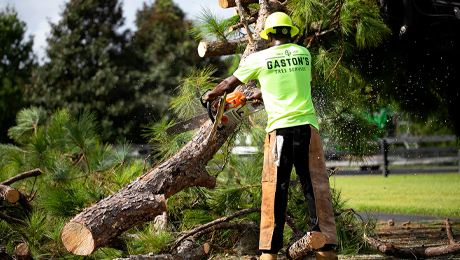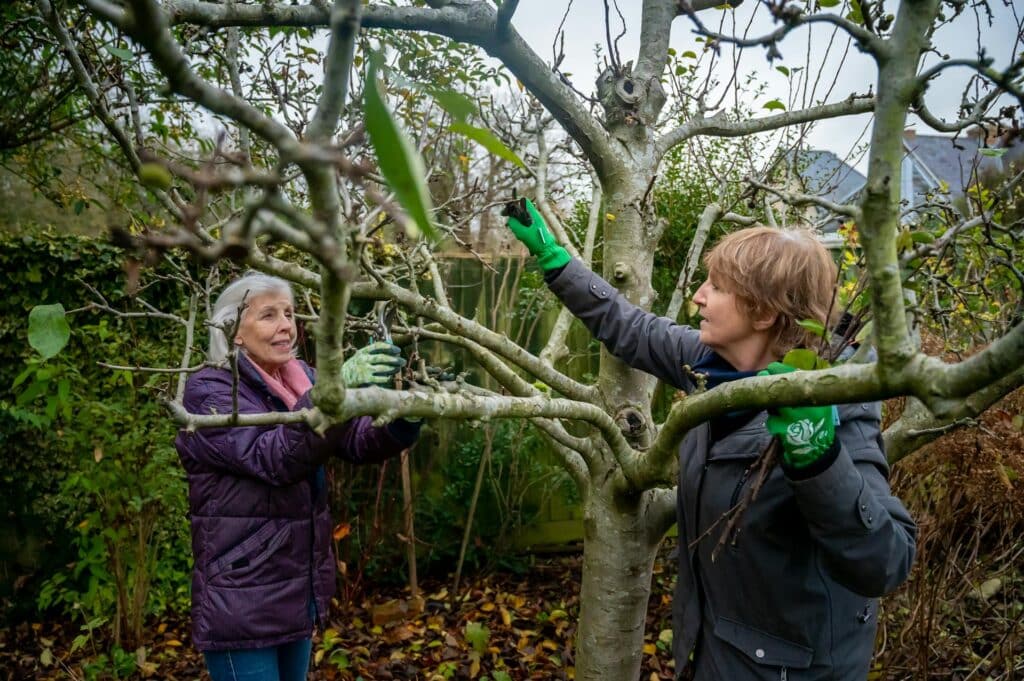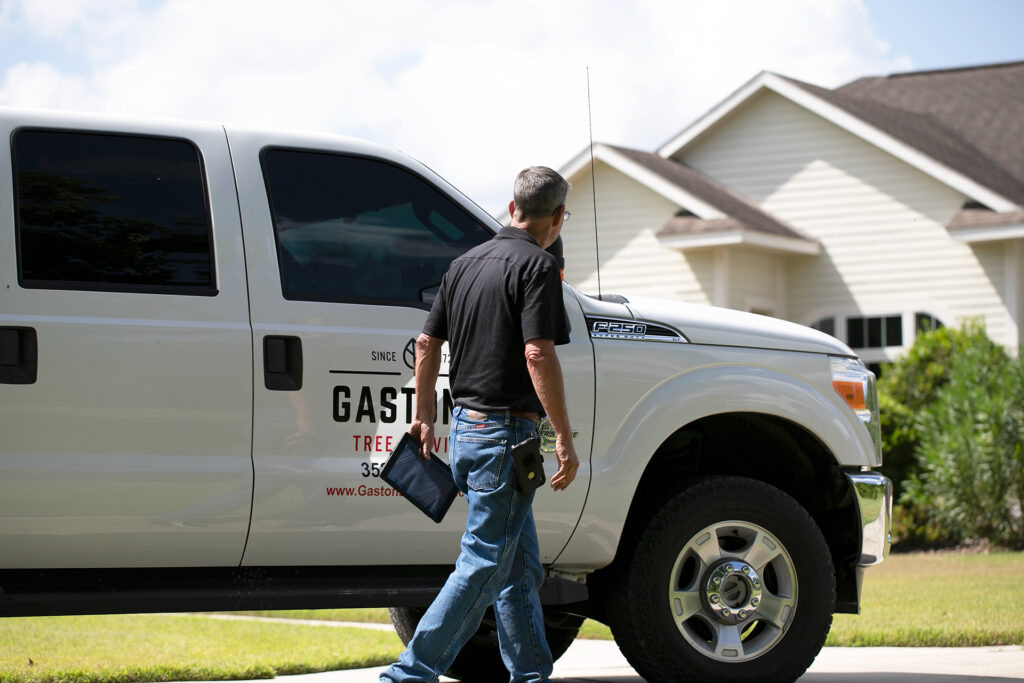If you’re looking for a new hobby that allows you to be outside more, starting DIY tree care is a great option! While this hobby does require some hard work and careful planning, some people enjoy the satisfaction of taking care of their own yard and learning more about their natural environment. Our guide provides insight into what you can safely do as a tree care DIYer and when you need to call in professional advice.
Tools You’ll Need for DIY Tree Care
Before you begin your hobby in tree care, you’ll want to gather some needed supplies and equipment you’ll need for the job. You can find most, if not all, of these tools at your local hardware or gardening store.
- Hand pruners
- Loppers
- A pruning saw or chainsaw
- High-quality mulch
- Safety goggles
- Gloves
- Outdoor boots
- A watering system, such as sprinklers
- Trimmers
- A small ladder or step stool
- A wheelbarrow
Safety First

Tree care can be and is a dangerous job. You could encounter falls, falling debris, and dangerous heavy machinery. In fact, statistics show that not only do tree workers suffer more serious injuries, but also that their fatality rate is higher than in other similar industries. If the professionals in the industry are at such high risk, as a hobbyist, you’ll want to take extra precautions and call a professional when the job is too big for a DIY project.
A good rule of thumb is that if your project requires you to be off the ground, you should have a professional handle it. However, if you’re a hobbyist of small trees, a small ladder (under 6 feet) with the proper safety precautions, such as a spotter, can be used at your own risk. To minimize chances of injury, also wear safety gear such as a hard helmet, gloves, and eye goggles—even if you’re on the ground.
How Can I Start Fresh?
If you’re looking for the full tree life cycle experience, caring for a young tree will differ slightly from caring for already established, mature trees. So if you’re ready for some new tree growth in your yard, here’s how you can care for young trees yourself!
1. Select a Tree
The first step to becoming an amateur arborist is knowing the best tree to select for your yard. There are a few factors that you need to consider when choosing a tree:
- What trees work best for your environment?
- What look or type of tree do you want in your yard?
- How much maintenance does the tree need?
- How big can the tree get when it’s fully grown?
- Is your yard’s soil catered to the tree?
These questions can help you narrow down exactly what you’re looking for in a tree. For example, a tree for shade will have different needs than a tree that produces fresh fruit in your yard. If you’re going to a nursery, they should be able to answer your questions about their saplings.
2. Stake Your Tree
Once you have your sapling, a great way to encourage healthy trunk growth is staking your tree if need be. Now it’s important to note not all saplings need to be staked, but if you live in an area with high winds or if the sapling is unable to stand on its own, staking is a great option for additional support.
In order to properly stake the area, here are the steps you need to take:
- Get one or two stakes, a soft but flexible tie, and mulch. The stakes should be made of metal or strong wood. Also, avoid using a wire tie since these run the risk of damaging the trunk.
- Clear the area around the tree.
- Determine if you need two stakes or just one—you can do this by gently shaking the tree and seeing if the roots move with your movement.
- Place the stakes parallel to each other or in the direction of the wind if you’re just using one stake.
- Use the soft, flexible tie to secure the trunk of the sapling to the stake(s). The tie should be pretty far down the trunk in order to stabilize the roots.
- Place down mulch to keep the roots protected.
3. Pruning & Trimming for Structure
As your sapling grows, pruning and trimming are essential to healthy and sustainable growth. You’ll want to ensure your sapling has one leader branch (that will become the trunk) and organized branches growing off of it. Prune and trim your sapling to get the shape that you want, but make sure you don’t prune too much. Cutting too many branches can cause stress to a young tree. Good branches to prune for a young tree include:
- Dead or sick branches
- Loose branches
- Branches that will impede foot or car traffic
- A secondary leader branch
How Do I Make My Tree Healthy Again?

If your DIY tree care is more catered to the mature trees already in your yard, you’ll want to focus on maintenance and keeping your trees healthy and alive. While a mature tree may not require as much attention as a young, growing tree, you’ll want to add these tree care habits into your routine.
1. Know the Signs
The biggest thing you can do for your mature trees is know the signs of a dying one. By catching the signs of sickness early in a tree, you can intervene before you’re left with a dead tree. Some of the signs include:
- Brittle dark
- Discolored or losing leaves when it’s not cold
- Increased pest activity around the tree
- Leaning
- Root damage
If you want more information on what a dying tree looks like, read more on the topic in our guide here!
2. Make Your Own Fertilizer
A great DIY project to help your trees stay healthy is making your own fertilizer and adding it to your soil. Many people do this through a process called composting. This process involves taking natural food scrapes, such as banana peels, egg shells, and even coffee grinds, and allowing them to slowly break down into a nutrient-dense fertilizer.
It’s also a great way to recycle materials that would have gone to waste otherwise! While this process can take a few weeks or even months to complete, it’s a great way to provide DIY care to your trees and live a greener lifestyle. Check out a beginner’s guide to composting to get started!
3. Promote Natural Healing
Perhaps the most important step of DIY tree care is carefully sorting through information to ensure what someone recommends isn’t harming your tree. For example, you may find several articles promoting the practice of wound dressing trees when they get injured. However, many sources are now stating that wound dressing does more harm to your tree than good by blocking oxygen.
The best way to heal a wound on a mature tree is to promote natural healing by keeping the area shaded to avoid sunburn, well-circulated with air, and free of pests that may make the wound worse. Increasing nutrients in the soil can also provide the needed materials for the tree to heal properly.
When Do I Need a Certified Arborist?

When a job becomes too big or challenging, it’s time to call in a professional. As we mentioned before, tree care can be a dangerous task, and your safety comes first. So here are a few cases where it’s better to call in a certified arborist rather than continue doing DIY tree care:
- The task requires you to be on a ladder.
- The tree needs to be removed.
- The tree is dead.
- A large branch needs to be removed.
- You’re in need of emergency services after a natural disaster.
- You need help pruning your tree to prevent damage before a storm.
- You’re unsure what’s wrong with a diseased tree.
- You’re having conflict with your neighbor over tree boundaries.
- You feel unsafe with the task that needs to be completed.
- You have a stump that needs removing.
- Your branches are growing into electrical wires.
Remember, our rule of thumb is if the job requires your feet to be off the ground, it’s better to get a professional involved.
Trust Your Tree’s Care with Gaston’s Tree Service
Whether you have a task that’s unsafe for you to perform or you just need a helping hand in your tree’s care, Gaston’s Tree Service is here for all your tree needs. Our team of certified arborists are skilled in handling Florida trees—from pruning and maintenance to removal and grinding stumps, we ensure you’re happy with your yard! Need help with your next project, reach out today to get a free quote, and see how we can help!
